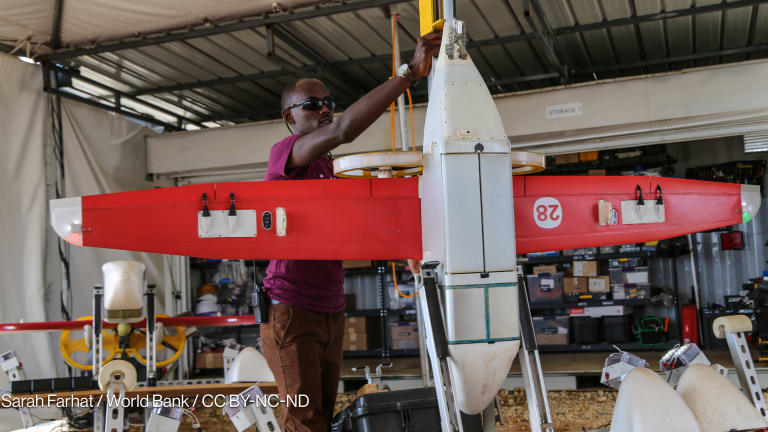
In recent years, mergers and acquisitions have become more frequent in international development as NGO and business leaders seek ways to improve the efficiency and effectiveness of their anti-poverty work around the globe.
The latest illustration of this trend came Tuesday (Oct. 4), when GRM International and the Futures Group publicly announced a merger. Their newly created holding company, Futures Global, has a combined revenue of $225 million, and arrives mere months after FHI’s acquisition of AED created FHI 360, a global giant that now ranks as top implementing partner of the U.S. Agency for International Development, the world’s largest bilateral donor.
Devex spoke with GRM International Managing Director Kim Bredhauer and Futures Group CEO Chris LeGrand prior to the announcement about the reasons behind the merger and how they plan to position their companies in a fast-changing development landscape.
Reaching new markets — was that the impetus for this merger?
Chris LeGrand: The real impetus for the merger on both sides was really about growth. We see, increasingly, a need to integrate multisectoral approaches to development. And so, the real focus was around growth, growing our markets here in the U.S. into adjacent areas and then within GRM’s traditional donor areas, being able to actively pursue health projects there, large enough projects that neither organization was really in the position to pursue before.
Kim Bredhauer: The whole impetus for the merger is about growth. From GRM’s side, we’re a major contractor of AusAid — we’re one of the top three contractors and have been for a number of years; we’re the first of the Australian development companies to move overseas into other clients such as DfID et cetera. And we’re now doing quite a lot of work with DfID and DfID is a growing market for us. The logical next step for us is USAID. And the benefits that we think we can bring by working seamlessly across these three major bilateral clients is the learning from each of these agencies and what they’re doing, and the benefits that will bring to the people that we’re working with on projects.
>> Mergers and Acquisitions: A Smart Business Move?
Are you planning to reach out to new donors you haven’t worked with in the past?
Bredhauer: Probably not new donors so much as having a wider offering for some of the donors with whom we now only have small bits of work. We do a reasonable amount between us with the European Union. We’re also doing work with the Swiss, and have over the past years done quite a bit of work with the Swedish development agency Sida. So, there are a number of areas where we can offer more to these clients and create opportunities for growth there.
LeGrand: Futures Group has had some work with private foundations, but again, that’s been fairly narrowly focused. And we believe with the substantial capabilities that GRM has, we’ll have a much broader offering for large private foundations to be able to pursue grants and implement programs on their behalf.
The influence of foundations, corporations and other nontraditional donors is rising as many bilateral governments cut their foreign aid spending. How do you plan to address the challenge of broadening your donor base?
LeGrand: Your point’s a good one, and we’ve been seeing that trend as well. It’s not that large governments and multilateral donors are going away, but some of the challenges we’ve seen in international development are frankly just too large for those traditional donors to deal with effectively. And we’re finding increasingly that it’s not just about finding new donor sources — whether it’s philanthropy or corporate social responsibility — we’re really beginning to leverage the private sector in bringing what they can bring in kind. They have to see a business need for it. But we see increasingly, it’s a fabric of people who can bring things to the table to solve the world’s challenging development problems. We want to be front and center and one of the leaders in paving that way.
Bredhauer: On the Australian side and the British side, things are the opposite — they’re both dialing up, and grappling with the challenges of how to deliver much larger aid programs effectively and deliver value for money back to their constituents. I think this is going to get organizations like us now who have the depth and size to manage much larger projects. And we’ll be able to offer more solutions to their clients such as AusAID and DfID who are trying to scale up and having enormous challenges in doing that.
There’s also changing trends; there’s a trend in DfID and less so with AusAID in grant financing and using contractors such as us to manage grant financing through local community-based organizations. Whereas traditionally they haven’t been spending too much money through NGOs, they now want to be able to push more money through these community-based organizations, the indigenous ones in the areas we’re working in. We’re doing a number of projects in that area; these are the sort of things that smaller companies have trouble grappling with because the amount of money passing through is quite large and the margins are so small that it’s difficult for them. With our increased size, we are being be able to better handle these sort of programs.
How important is it, really, to be large in size to convince USAID and other donors that you can provide the biggest bang for their buck?
LeGrand: There are already a number of large players in the USAID market and there are large-scale programs. We actually don’t see that part of USAID’s portfolio growing. If anything, USAID has signaled an interest in more focused capabilities to address these current issues in nontraditional ways. That’s why we think that bringing best practice from different donors to bear is a really [good] approach to servicing USAID as well. I think they’re realizing we’re probably be flat-budgeted in the U.S., they can’t do all the things the way they used to, they have to look for new approaches, new ways at get at these development problems that we’re all trying to address.
Bredhauer: There’s an interesting point there, that across the donors, some of them do some things very well. There’s a whole lot of lessons that can be learned between DfID, AusAID and USAID. And I think the way that we’re structured — we operate pretty seamlessly across the globe and we will with Futures as part of the organization — we’re unique in bringing to bear those learnings from projects that are funded by various donors across the other organizations. I think a lot of our competitors operate in silos, and therefore there’s not that cross-fertilization.
Competition, as you mentioned, is stiff in international development. In the United States, for instance, many of your competitors, like FHI 360, have a focus on health, many operate around the globe. What makes you stand out?
LeGrand: This [merger] puts us in a place where we are plenty large, able to take on any-size project that USAID has. But we’re not so large that we can’t continue to be nimble, flexible and bring innovation. It’s been one of our hallmarks of Futures that we’re able to really turn on that dial when we need to in developing countries when you see new trends or approaches that work, or approaches that aren’t working and that you need to abandon.
The other good thing about our combined organization is that as for-profit companies, we’re geared toward results. And increasingly, USAID has to deal with producing results. The days of just throwing a bunch of money at a problem are gone, so they must frankly shift to more of a model that AusAID and DfID have looked at in terms of getting value for money. So we think that as an organization that’s organized for tax purposes as a for-profit, we know how to produce results efficiently.
>> FHI Acquires AED: A Conversation With CEOs Albert Siemens and Gregory Niblett
How will this merger affect staffing?
LeGrand: This merger was about growth, about getting growth out of the combined organizations, not out of improving the bottom line through cost-cutting. We will not be laying off anybody as a result of this. That’s reflected in the way we’re going to operate fairly autonomously. GRM already operates through three business units, which focus on our main clients and geographic areas. Futures will operate as a business unit on certain clients and geographic areas. Those areas may overlap, of course, so that’s where the sharing comes about.
We expect our combined turnover of more than $200 million to grow significantly over the next few years, for Futures to grow into other sectors within the USAID market. There will be hiring of people with expertise in democracy and governance, law and justice. There will be opportunities for the staff of Futures to work on more DfID, AusAID projects in other parts of the world where they haven’t been, and for the GRM people to work on USAID projects and in other areas.
But you will not clearly define that, for instance, all DfID business will be handled by GRM, and some staff may eventually shift from one organization or location to another as a result?
Bredhauer: Over time, there will be a natural progression with new projects, depending on where a project’s based and where it’s managed from. The existing programs that are being run will not be changed at all.
Over time, there may be new opportunities to bring new resources to those projects from the broader group and bring some added expertise we might not have had access to previously. But as new projects come on, we’ll be looking at the best ways to manage them to satisfy the needs of our clients who are paying as well as the beneficiaries.
How will this merger affect the brand and how quickly will internal reforms be implemented?
Bredhauer: The essence of it is that we come together on the one holding group. Below that, Futures will retain the same corporate entity et cetera, and will remain majority U.S.-citizen-owned and will be responsible for focusing on the USAID market, but also provide resources on health and other areas where we work with AusAID and DfID. As I mentioned before, we have three business unit — one is based out of Brisbane, which focuses on the Asia-Pacific area and has AusAID as a key client. Another one is based out of London, which covers West and Southern Africa, Central Asia and Europe, and there will be some merging of operations of the Futures operations in that areas with our London West Africa operations. Our Dubai office focuses on the Middle East and North Africa South Asia area, which is a major area operation for USAID, so we expect a lot of cooperation in the early years between the Washington business unit, which is basically Futures, with our Dubai operation because it is so logistically close to quite a number of countries that are important to USAID.
We’ll continue to operate under two separate brands and we’ll come together where it’s a benefit to win and implement new projects. We’ll never bid against each other on anything because we are one organization, and I don’t think that’s fair to a client if we try to do anything like that.
LeGrand: Each of us has already operated this way. At Futures, for example, we have a subsidiary in India and we have a subsidiary in the U.K. to service those local donor communities. But it’s all under one umbrella. So, we seamlessly provide capabilities of the entire operation to whatever the particular client’s need is, and we expect to be able to do that in a broader context as part of this broader holding company. So, it’ll be internal agreements that’ll work very seamlessly for our clients to be able to deliver the best people and approaches to solve development problems.
Will there be any leadership changes?
Bredhauer: Hope not. (laughs)
LeGrand: No plans for that at all.








